Explore Wangdue Phodrang - Bhutan Travel, Asia
Wangdue Phodrang is a stunning district renowned for its untouched beauty and rich cultural heritage. This picturesque region, located just a few hours' drive from the capital Thimphu, offers travelers the perfect mix of scenic landscapes, fascinating history, and serene monasteries. With its winding rivers, lush valleys, and majestic mountains, Wangdue Phodrang is rapidly gaining popularity among visitors looking to experience authentic Bhutan. Whether you want to explore historic Dzongs, hike through pristine nature reserves, or just immerse yourself in local culture, this region has something for everyone.
Population: Approximately 9,000 in 2017.
Economy: Wangdue Phodrang's economy is primarily agriculture-based, including farming, livestock rearing, and small-scale handicrafts. Tourism also contributes significantly, driven by its cultural and natural attractions.
Landmarks: Famous for the Wangdue Phodrang Dzong, Phobjikha Valley, and the Gangtey Monastery.
Bhutan
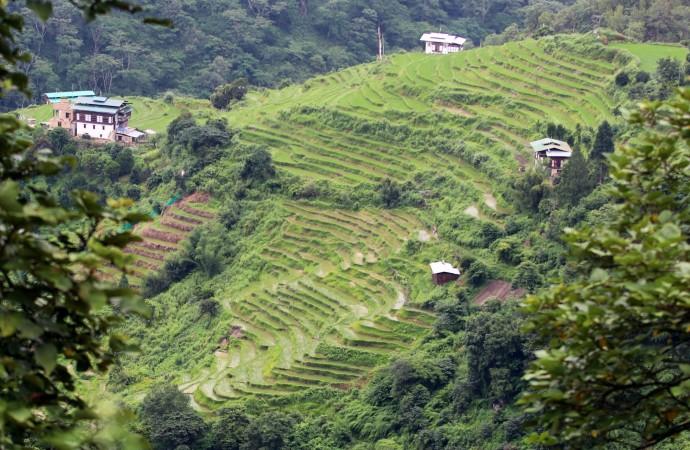
Overview of Wangdue Phodrang
History & Cultural Influence
Wangdue Phodrang's history dates back to the 17th century when Zhabdrung Ngawang Namgyel, the unifier of Bhutan, founded the iconic Wangdue Phodrang Dzong in 1638. The influence of Buddhism takes root in every corner of this place with ancient monasteries and sacred sites reflecting the deep spiritual roots of the region. The Gangtey Monastery, perched atop a ridge overlooking the Phobjikha Valley, is one of the holiest sites in Bhutan. Beyond its religious significance, Wangdue Phodrang’s cultural heritage is deeply intertwined with its local communities. Traditional Bhutanese architecture, folk dances, and customs thrive here, offering visitors a unique glimpse into the country's rich past.
Interaction with The Locals
Wangdue Phodrang is home to a small, close-knit population, primarily consisting of Bhutanese citizens from various ethnic groups such as the Ngalop, Sharchop, and Lhotshampa. The locals are known for their warm hospitality and deep-rooted Buddhist traditions. Agriculture plays a significant role in their daily lives, with many residents engaged in farming and livestock rearing. While the district is rural, the people of Wangdue Phodrang maintain a strong sense of community, preserving their cultural heritage and traditional way of life.

Wangdue Phodrang Dzong - © Business Bhutan
Top Attractions in Wangdue Phodrang
Wangdue Phodrang is home to some of Bhutan’s most captivating landmarks and natural wonders, from historic fortresses to tranquil valleys, these must-visit attractions will leave you in awe.
Wangdue Phodrang Dzong
The Wangdue Phodrang Dzong is an ancient fortress once served as a defensive stronghold and continues to be a symbol of Bhutanese heritage. Its location atop a hill offers visitors breathtaking views of the valley and rivers below. While it is currently undergoing reconstruction, visiting the Dzong remains a must for its historical significance and architectural beauty.
Phobjikha Valley
Phobjikha Valley, also known as the "valley of the black-necked cranes," is a pristine glacial valley surrounded by dense pine forests. It's an ideal destination for those who love hiking, bird watching, and photography. In winter, the valley becomes a sanctuary for the endangered black-necked cranes, making it a perfect time to visit for nature enthusiasts.
Gangtey Monastery
The Gangtey Monastery, located above Phobjikha Valley, is one of Bhutan's oldest and most sacred religious places to its people. The monastery’s stunning location, combined with its rich spiritual atmosphere, makes it a must-visit for those seeking tranquility and insight into Bhutanese Buddhist practices.
Jigme Dorji National Park
For adventure seekers, Jigme Dorji National Park offers incredible trekking routes, wildlife sightings, and the chance to explore one of Bhutan’s most biodiverse regions. This national park is home to various rare species such as snow leopards, Bengal tigers, and red pandas, as well as hundreds of plant species.
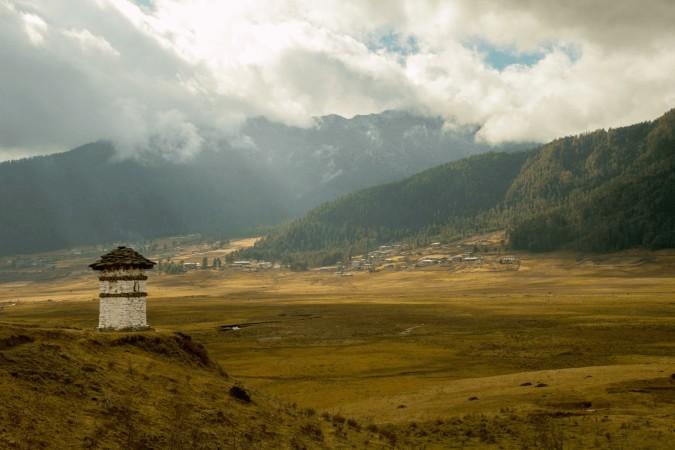
Phobjikha Valley - © School for Field Studies
Must-Try Dishes in Wangdue Phodrang
Wangdue Phodrang offers a flavorful dive into Bhutanese cuisine, known for its simplicity and the bold use of spices, particularly chilies. Each of these dishes showcases the richness and variety of Bhutanese cuisine, from fiery chilies to hearty, savory meals.
- Ema Datshi: The national dish of Bhutan, Ema Datshi, is a spicy and creamy dish made from green chilies and local cheese. It is served with rice and is a staple in most Bhutanese households. The heat from the chilies, combined with the richness of the cheese, creates an unforgettable flavor.
- Phaksha Paa: This substantial pork meal is popular among the locals. Phaksha Paa is a stir-fried pork dish made with dried chiles, garlic, radish, and leafy greens. Its rich, savory flavor makes it a delightful and filling supper that is typically served with red or white rice.
- Jasha Maroo: Jasha Maroo is a chicken dish famous for its soft chicken pieces cooked in a spicy sauce composed with chilies, garlic, ginger, and tomatoes which makes it slightly less intense in heat compared to Ema Datshi, making it a delicious option for those looking for a balance of spice and flavor.
- Hoentay: Originally from the Haa Valley, Hoentay is also enjoyed in Wangdue Phodrang. These dumplings are made from buckwheat dough and stuffed with a mix of spinach, cheese, and other herbs. Often steamed or fried, they’re served with a spicy dipping sauce and are perfect for a light snack or meal.
- Puta: Puta is a traditional Bhutanese buckwheat noodle dish that is particularly common in the western parts of the country, including Wangdue Phodrang. The noodles are boiled and stir-fried with garlic, onions, and sometimes meat or eggs.
- Suja (Butter Tea): Suja, or butter tea, is a fundamental part of every Bhutanese meal. This traditional beverage, made from tea leaves, yak butter, and salt, has a unique savory taste.
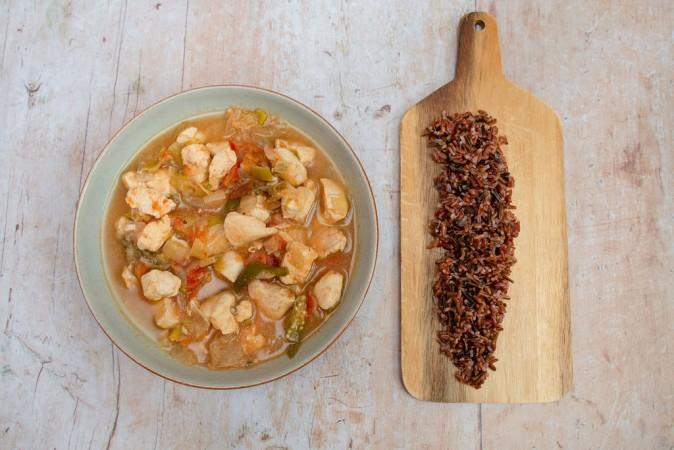
Jasha Maroo - © Jess Eats and Travels ( @christy blanch)
Festivals & Local Celebrations
Wangdue Phodrang comes alive during its vibrant festivals, which reflect Bhutan's deep-rooted spiritual traditions and community spirit. These celebrations provide travelers with a window into Bhutanese culture, featuring colorful dances, rituals, and joyous gatherings.
Wangdue Tshechu
The Wangdue Tshechu is one of the district's most significant festivals, held annually in the fall. This three-day Buddhist celebration features traditional mask dances, performed by monks and locals to depict the victory of good over evil. Visitors are welcome to join the festivities, where they can witness sacred rituals and vibrant costumes while soaking in the lively atmosphere.
Gangtey Tshechu
Held at the Gangtey Monastery, the Gangtey Tshechu is another important festival that draws both locals and tourists. This celebration, dedicated to the teachings of Guru Rinpoche, features religious mask dances, blessings, and prayers. The festival coincides with the arrival of black-necked cranes in the nearby Phobjikha Valley, adding to its spiritual significance.
Black-Necked Crane Festival
Taking place in Phobjikha Valley every November, the Black-Necked Crane Festival celebrates the annual return of these endangered birds. Locals organize cultural performances, crane-themed dances, and educational activities to promote conservation efforts. The festival is a unique blend of cultural celebration and environmental awareness, making it a meaningful event for nature lovers.

Wangdue Tshechu - © Bhutan Tourism
What to Do in Wangdue Phodrang
- Trekking & Hiking in Wangdue Phodrang: The lush landscapes of Phobjikha Valley and Jigme Dorji National Park offer various trekking trails suitable for all levels. The Gangtey Nature Trail is a popular short hike that takes you through stunning forests, farmlands, and offers panoramic views of Phobjikha Valley. For more seasoned trekkers, the Snowman Trek—considered one of the toughest in the world—begins in Wangdue Phodrang and offers a challenging adventure through high-altitude passes and remote wilderness.
- Cultural Tours: Tours of the Gangtey Monastery and Wangdue Phodrang Dzong offer deep insights into Bhutan’s spiritual and architectural heritage. The serene atmosphere of these religious sites provides a peaceful retreat for visitors looking to connect with Bhutanese culture.
- Bird Watching in Phobjikha Valley: Phobjikha Valley is famous for being the winter home of the rare black-necked cranes, making it a top destination for bird watchers. The best time to observe these majestic birds is from November to February, when they migrate from Tibet.
- River Rafting in Punakha River: For those seeking adventure, the Punakha River offers thrilling river rafting experiences. With rapids that cater to both beginners and experienced rafters, this activity is a perfect way to enjoy the region’s scenic beauty from a different perspective.
Shopping in Wangdue Phodrang
- Bhutanese Textiles Shops: Bhutanese textiles are highly valued for their intricate designs and quality craftsmanship. In Wangdue Phodrang local market, you’ll find locally woven items such as Kiras (traditional women’s attire) and Ghos (men’s attire). The vibrant patterns and natural dyes used in these garments reflect the region’s artistic flair and make for a unique souvenir.
- Handwoven Baskets Stores: The locals in Wangdue Phodrang are known for their skill in weaving sturdy and beautifully designed baskets, made from bamboo or cane. These baskets, used traditionally for carrying crops, can be found in local markets and are both functional and decorative.
- Traditional Masks Specialty Shop: Traditional Bhutanese masks, often used in religious festivals, are a popular item among visitors. These masks are hand-carved and painted with bright colors, representing deities, animals, or mythical creatures. They make for striking decorations or meaningful keepsakes from your journey.
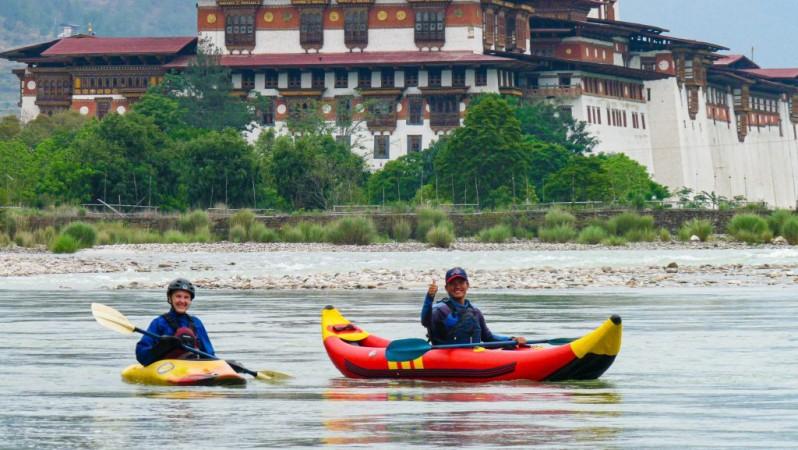
River Rafting in Punakha River - © Bhutan Tourism
Weather in Wangdue Phodrang: Best Time to Visit
Spring in Wangdue Phodrang
Spring is one of the best times to visit Wangdue Phodrang. The weather is pleasant, with temperatures ranging from 10°C to 25°C (50°F to 77°F). The landscape bursts into color with blooming rhododendrons and lush greenery, making it perfect for hiking and sightseeing. Festivals such as the Wangdue Tshechu also take place during this period, offering a rich cultural experience.
Summer in Wangdue Phodrang
Summer comes along with the monsoon season, which provides considerable rainfall to the region, with temperatures are about 15°C to 30°C (59°F to 86°F). While the rain transforms the valley into a lush, green paradise, it can also make travel and outdoor activities more challenging due to muddy roads and slippery trekking paths. However, this season is ideal for travelers who prefer a quieter experience and want to enjoy the landscapes without the crowds.
Autumn in Wangdue Phodrang
Autumn is another peak season for tourism in Wangdue Phodrang, as the weather is cool and dry. Temperatures normally range between 10°C and 20°C (50°F to 68°F). The sky is typically clear, providing breathtaking vistas of the surrounding mountains and valleys. Autumn is also the season for the Black-Necked Crane Festival, a unique event that combines nature and culture, making it a fantastic time for bird watching and wildlife photography.
Winter in Wangdue Phodrang
Winter in Wangdue Phodrang is chilly, with temperatures varying between -5°C to 10°C (23°F to 50°F). While the region doesn’t receive heavy snowfall, the air is crisp, and the landscape can be quite serene. This is the perfect season to spot the endangered black-necked cranes in Phobjikha Valley. Winter travelers should pack warm clothes but will be rewarded with fewer tourists and more peaceful surroundings.
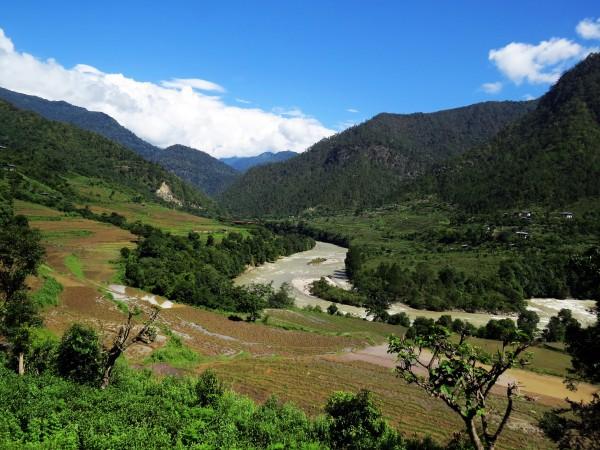
Jigme Dorji National Park - © Wikipedia
Essential Travel Information
Getting Around Wangdue Phodrang
- Taxis: Taxis are a common mode of transport and can be easily arranged through your hotel or a local taxi stand. It’s recommended to negotiate the fare beforehand, as meters are not always used.
- Private Car Rental: For more flexibility, renting a private vehicle with a driver is a great option. Many tourists choose this option as it allows them to explore remote areas like Phobjikha Valley at their own pace.
- Public Buses: Public buses operate between major towns and districts in Bhutan, including Wangdue Phodrang. While this is the most affordable option, buses can be slow and schedules are often limited, making it less convenient for travelers with tight schedules.
ATM & Banking Services
ATM and banking services in Wangdue Phodrang are relatively limited due to its rural nature, so travelers are advised to plan ahead. While a few ATMs are available in the main town areas, they can sometimes be unreliable or out of service, especially during busy periods. It’s recommended to withdraw cash in larger cities like Thimphu or Paro before heading to Wangdue Phodrang. Currency exchange options are scarce, and most smaller establishments prefer cash payments, so it's important to carry enough local currency for daily expenses.
Where to Stay in Wangdue Phodrang
- Luxury Hotels: Luxury hotels and resorts in the area provide world-class amenities and stunning views of the surrounding landscapes. These hotels frequently include traditional Bhutanese architecture coupled with modern amenities.
- Guesthouses: Budget-conscious travelers will find a range of guesthouses in Wangdue Phodrang that provide clean and comfortable rooms at affordable prices. These smaller accommodations may not have the luxury amenities of high-end hotels, but they offer basic necessities and are a great way to stay close to local attractions while keeping costs low.
- Homestays: Homestays allow travelers to live with a Bhutanese family, participate in daily activities, and enjoy home-cooked meals. This is an excellent choice for those who want to immerse themselves in Bhutanese culture and traditions, while also supporting local communities.
Articles for you

Explore Yala National Park - Sri Lanka Travel, Asia
Tucked away in Sri Lanka’s southeastern corner, Yala National Park is where wild nature meets deep tradition. Known worldwide for its leopard population, the park is also home to elephants, sloth bears, crocodiles, and hundreds of bird species. Beyond wildlife, Yala opens doors to a cultural landscape dotted with ancient temples, Buddhist ruins, and coastal villages. For travelers seeking more than just a safari, Yala offers a chance to explore eco-tourism, local communities, and sacred heritage sites.
Population: The Yala National Park area doesn’t have a human population.
Economy: The economy around Yala National Park thrives on a blend of eco-tourism, agriculture, and local services. Safari tours, eco-lodges, and cultural experiences drive steady income for nearby towns like Tissamaharama and Kataragama, supporting thousands of families.
Landmarks: Famous for Block I of Yala and wildlife encounters, including elephants, sloth bears, crocodiles, and exotic bird species.

Explore Galle - Sri Lanka Travel, Asia
Nestled on Sri Lanka’s southern coastline, Galle is a vibrant city where history meets the sea. Its cobbled streets, colonial architecture, and serene beaches make it a must-visit destination for travelers seeking a blend of culture, adventure, and relaxation. A UNESCO World Heritage site, Galle captivates visitors with its Dutch Fort, bustling markets, and friendly locals. Whether you’re exploring the ramparts at sunset or savoring fresh seafood by the shore, Galle promises an unforgettable journey into Sri Lanka’s heritage.
Population: Approximately 113,000 in 2023.
Economy: Galle’s economy thrives on tourism, trade, and fisheries. The city’s historic fort, colonial architecture, and coastal charm draw thousands of international visitors each year, making tourism its main economic driver. Fishing remains vital for local livelihoods, supplying fresh seafood across the region.
Landmarks: Famous for the Galle Fort, Dutch Reformed Church & Maritime Museum, and Unawatuna Beach.

Explore Bentota - Sri Lanka Travel, Asia
Nestled along Sri Lanka’s southwestern coast, Bentota is a tropical paradise that blends golden beaches, vibrant culture, and thrilling adventures. Famous for its calm waters, luxury resorts, and scenic river estuary, Bentota has become a top destination for travelers seeking both relaxation and authentic experiences. From serene beach walks at sunrise to adrenaline-pumping water sports, this coastal town offers a perfect balance of leisure and exploration. With its proximity to Colombo and Galle, Bentota is easy to reach, making it an ideal stop for both short escapes and extended holidays.
Population: Approximately 37,000 in 2023.
Economy: Bentota’s economy thrives mainly on tourism, which drives local businesses such as hotels, restaurants, and wellness retreats. The town also benefits from fishing, coconut cultivation, and handicrafts like wood carving and batik textiles. Many residents rely on the growing demand for water sports and Ayurvedic treatments, making tourism the backbone of both income and employment in the area.
Landmarks: Famous for Bentota Beach, Bentota River Safari, and Kande Vihara Temple.

Explore Mirissa - Sri Lanka Travel, Asia
Mirissa is a charming coastal town on Sri Lanka’s southern shoreline. Known for its golden beaches, turquoise waters, and vibrant marine life, it has become a must-visit stop for travelers exploring the island. Many come for whale watching, surfing, and sunset views at Coconut Tree Hill, but Mirissa offers much more than postcard beauty. The fishing boats you see anchored by the bay carry generations of stories. Local traditions, delicious cuisine, and a laid-back rhythm of life shape every visitor’s experience.
Population: Approximately 4,700 in 2023.
Economy: Mirissa’s economy is largely shaped by its coastal location. Fishing has long been the backbone of local livelihoods, with generations relying on the Indian Ocean for income. In recent decades, tourism has become the main driver of growth, thanks to whale watching, surfing, and beachside hospitality.
Landmarks: Famous for Mirissa Beach, Coconut Tree Hill, and Parrot Rock Bridge.

Explore Nuwara Eliya - Sri Lanka Travel, Asia
Tucked away in the Central Highlands of Sri Lanka, Nuwara Eliya is often called “Little England”. With its rolling tea plantations, cool misty mornings, and colonial charm, this mountain town feels like a step into another world. Travelers come here to breathe fresh air, walk through flower gardens, sip the finest Ceylon Tea, and enjoy a pace of life far from the island’s busy cities. Whether you’re drawn by scenic landscapes, heritage architecture, or the warmth of its people, Nuwara Eliya is a destination that blends nature, culture, and history in perfect harmony.
Population: Approximately 781,000 in 2023.
Economy: Nuwara Eliya’s economy thrives mainly on tea production, as it sits in the heart of Sri Lanka’s central highlands, famous worldwide for Ceylon Tea. The city also benefits from a growing tourism industry, attracting visitors with its colonial charm, cool climate, and scenic landscapes.
Landmarks: Famous for Gregory Lake, Hakgala Botanical Garden, and Victoria Park.

Explore Sukau - Malaysia Travel, Asia
Nestled on the banks of the Kinabatangan River in Sabah, Malaysian Borneo, Sukau is a destination where wildlife, culture, and conservation come together. Known as one of Asia’s top spots for river safaris and eco-tourism, this quiet village offers a front-row seat to encounters with Bornean orangutans, pygmy elephants, proboscis monkeys, and exotic birdlife.
Population: Approximately 1,400 in 2019.
Economy: Sukau’s economy is shaped by its riverine location and natural resources. Traditionally, the Orang Sungai community relied on fishing, small-scale farming, and forest gathering for their livelihood. Today, the village has shifted toward eco-tourism, with river cruises, jungle trekking, and homestays providing income.
Landmarks: Famous for the Kinabatangan River cruises, Gomantong Caves, and Ox-bow lakes and wetlands.
